U n i v e r s i t é Y O R K U n i v e r s i t y
ATKINSON FACULTY OF LIBERAL AND PROFESSIONAL STUDIES
SCHOOL OF ANALYTIC STUDIES & INFORMATION TECHNOLOGY
S C I E N C E A N D T E C H N O L O G Y S T U D I E S
NATS 1800 6.0 SCIENCE AND EVERYDAY PHENOMENA
ATKINSON FACULTY OF LIBERAL AND PROFESSIONAL STUDIES
SCHOOL OF ANALYTIC STUDIES & INFORMATION TECHNOLOGY
S C I E N C E A N D T E C H N O L O G Y S T U D I E S
NATS 1800 6.0 SCIENCE AND EVERYDAY PHENOMENA
Lecture 8: Sustainability: Renewable Energy Resources
| Prev | Next | Search | Syllabus | Selected References | Home |
Topics
-
A process is considered sustainable if it can continue to run indefinitely,
without depleting the energy and/or material resources on which it depends, directly or indirectly. This definition
is adapted and expanded from a similar one in Environmental Science, an excellent textbook by B J Nebel and
R T Wright (6th edition, Prentice Hall, 1998). Of course this definition must be understood as a relative statement,
since it is not really possible for any process not to waste some amount of energy. As you know, "there is no such thing
as a free lunch." See, for instance, G P Collins's brief article in Scientific American: Selling the Free Lunch: Perpetual Motion Has Changed Its Name But Not Its Methods.
Notice also that, in order to deal, in a meaningful way, with the issue of alternative, renewable energy sources,
one must deal not only with the necessary infrastructure (facilities, production, management, distribution, etc.),
but with the environment as a complex system. This means, for example, to ensure that a new, 'clean' technology may
not depend, directly or indirectly, on some 'dirty' technology. More importantly, this means that, no matter how attractive
a new technology may appear, we must try to evaluate its impact on the environment as a whole. This is definitely
not easy. The familiar 'environmental impact assessment' studies usually can only cover relatively local
issues. This is important, but it's not sufficient. As we saw in the previous lecture, complex systems are … complex!
In other words, it is often extremely difficult, if not impossible, to assess the repercussions of the introduction of a new
element in the system. Read for example,
 GM Salmon Muscle In on Wild Fish When Food Is Scarce :
GM Salmon Muscle In on Wild Fish When Food Is Scarce :
"… new laboratory research has found that wild salmon tend to experience reduced growth in the company of salmon engineered to attain a large body size. The presence of transgenic fish also increases the likelihood of population collapse when food is in short supply."
That is why, in these matters, we should always abide by some principle of prudence, such as the so-called precautionary principle. Read Precautionary Principle.
Here is one reasonable, but not perfect, definition of the Precautionary Principle, as stated in the 1989 Rio Declaration:
Precautionary Principle.
Here is one reasonable, but not perfect, definition of the Precautionary Principle, as stated in the 1989 Rio Declaration:
"Nations shall use the precautionary approach to protect the environment. Where there are threats of serious or irreversible damage, scientific uncertainty shall not be used to postpone cost-effective measures to prevent environmental degradation."
For a negative view of the principle, read
[ quoted in The Precautionary Principle and Scientific Research Are Not Antithetical ]
The Precautionary Principle and Scientific Research Are Not Antithetical ]
 More Sorry than Safe,
a recent article by Brendan O'Neill in Spiked, which starts with the following quote:
More Sorry than Safe,
a recent article by Brendan O'Neill in Spiked, which starts with the following quote:
"If everything we did had to be absolutely safe, risk-free, proven to have no adverse outcomes for anyone or anything, we'd never get anywhere. Buildings wouldn't go up, planes wouldn't get off the ground, medical breakthrough would come to a standstill, science would be stifled… Shall I go on?"
-
To review what is currently available in terms of renewable energy resources, you could start by visiting
Is there a Sustainable Solution for 6 Billion Humans on the Planet?,
a good introductory course at the University of Oregon. Other useful resources are provided by EERE (US Department
of Energy's Energy Efficiency and Renewable Energy): Learning About Renewable Energy,
and by the Subject Specific Information Tools of the US Office of Scientific and
Technical Information, which is a portal to resources on Photovoltaics, Geothermal Energy, Superconductivity, Wind
Energy, Biopower, Hydropower, etc. Other resources are listed below, under Readings, Resources and Questions.
Here are some of the major categories:
- Biomass
- Geothermal Energy
- Gravitation
- Hydrogen
- Solar Energy
- Tidal Energy
- Wind Energy
-
Let's briefly review these sources of alternative energy, and let's begin with biomass:
"We have used biomass energy or bioenergy—the energy from organic matter—for thousands of years, ever since people started burning wood to cook food or to keep warm. And today, wood is still our largest biomass energy resource. But many other sources of biomass can now be used, including plants, residues from agriculture or forestry, and the organic component of municipal and industrial wastes. Even the fumes from landfills can be used as a biomass energy source. The use of biomass energy has the potential to greatly reduce our greenhouse gas emissions. Biomass generates about the same amount of carbon dioxide as fossil fuels, but every time a new plant grows, carbon dioxide is actually removed from the atmosphere. The net emission of carbon dioxide will be zero as long as plants continue to be replenished for biomass energy purposes. These energy crops, such as fast-growing trees and grasses, are called biomass feedstocks. The use of biomass feedstocks can also help increase profits for the agricultural industry." [ from About Biomass Energy ]
The term 'biomass' actually covers a broad range of applications: from biofuels, resulting from the conversion of biomass into liquid fuels, and mainly used for transportation; to biopower, resulting from the direct burn of biomass to generate electricity; to bioproducts, resulting from the conversion of biomass into chemicals intended to replace those made from petroleum; etc."The two most common types of biofuels are ethanol and biodiesel. Ethanol is an alcohol, the same found in beer and wine. It is made by fermenting any biomass high in carbohydrates (starches, sugars, or celluloses) through a process similar to brewing beer. Ethanol is mostly used as a fuel additive to cut down a vehicle's carbon monoxide and other smog-causing emissions. But flexible-fuel vehicles, which run on mixtures of gasoline and up to 85% ethanol, are now available. Biodiesel is made by combining alcohol (usually methanol) with vegetable oil, animal fat, or recycled cooking greases. It can be used as an additive to reduce vehicle emissions (typically 20%) or in its pure form as a renewable alternative fuel for diesel engines. Other biofuels include methanol and reformulated gasoline components. Methanol, commonly called wood alcohol, is currently produced from natural gas, but could also be produced from biomass." [ from Introduction to Biofuels. This site has links to very interesting specific applications. ]
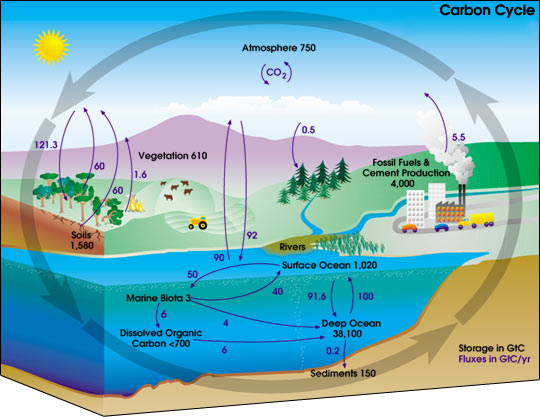
The Carbon Cycle
Do not forget that nature already uses biomass to generate a large proportion of its energy requirements. For example read Fact Sheet: Soil Profiles and Incremental Tree
Growth, Carbon Storage and the Carbon Cycle.
Fact Sheet: Soil Profiles and Incremental Tree
Growth, Carbon Storage and the Carbon Cycle.
-
"Geothermal resources range from shallow ground to hot water and rock several miles below Earth's surface,
and even farther down to the extremely high temperatures of molten rock called magma." [ from
Geothermal Energy ].
For example,
"Almost everywhere, the upper 10 feet of Earth's surface maintains a nearly constant temperature between 50 and 60 degrees F (10 and 16 degrees C). A geothermal heat pump system consists of pipes buried in the shallow ground near the building, a heat exchanger, and ductwork into the building. In winter, heat from the relatively warmer ground goes through the heat exchanger into the house. In summer, hot air from the house is pulled through the heat exchanger into the relatively cooler ground. Heat removed during the summer can be used as no-cost energy to heat water." [ ibidem ]
Even more interesting is the exploitation of underground steam and hot water often found about a mile or more below the surface. By digging deeper it may be possible to tap the heat of the molten magma itself, for example by heating water circulated through the deep rock just above the magma. A useful example of the exploitation of geothermal steam and hot water is Iceland (see, for example, Rafteikning HF ). - Gravitation has been used since 1973 to save energy in propelling and maneuvering space probes. For example, both Pioneer 10 amd Mariner 10 made use of the mechanism of 'gravitational assist' to reach and explore Jupiter, and Mercury, respectively. See, for example, Gravitational Slingshot.
-
Fuel cells are devices which produce electricity (plus water and heat) from the oxygen in the
air and another fuel, such as hydrogen. In principle, they are much more efficient than traditional devices, such as
the internal combustion engine. At present, however, the technology is not quite competitive, economically speaking,
compared to the highy polluting traditional technologies.
"As hydrogen flows into the fuel cell on the anode side, a platinum catalyst facilitates the separation of the hydrogen gas into electrons and protons (hydrogen ions). The hydrogen ions pass through the membrane (the center of the fuel cell) and, again with the help of a platinum catalyst, combine with oxygen and electrons on the cathode side, producing water. The electrons, which cannot pass through the membrane, flow from the anode to the cathode through an external circuit containing a motor or other electric load, which consumes the power generated by the cell. The voltage from one single cell is about 0.7 volts—just about enough for a light bulb—much less a car. When the cells are stacked in series, the operating voltage increases to 0.7 volts multiplied by the number of cells stacked." [ See Fuel Cells Explained ]
A very nice tutorial on fuel cells can be found by clicking on the link (scroll down) "Fuel Cell Animation" in Hydrogen, Fuel Cells & Infrastructure Technologies Program Hydrogen is one of the most important, but not the only fuel powering fuel cells for several reasons: it is the most abundant element in the universe, and it combines readily with other elements. The latter property is what makes hydrogen still an expensive substance, since it must be first separated. Various methods exist at present, such as the conversion of methane by steam in the presence of nickel as a catalyst, or the direct extraction from water by sunlight (which is the method used by most microorganisms). Such technologies are expensive, but otherwise viable. For instance the electrical systems of the US Space Shuttles use hydrogen fuel cells, and the astronauts drink the water produced by these cells.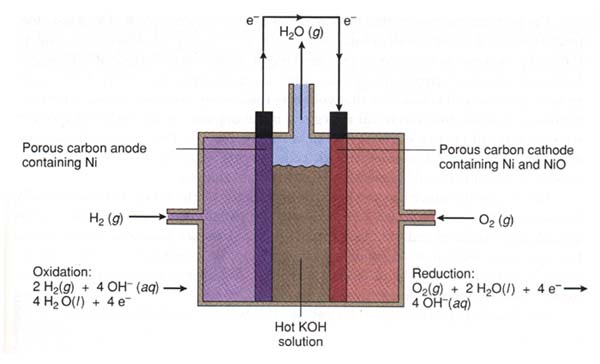
Schematic Diagram of Fuel Cell
I mentioned earlier that it is important to identify the hidden costs of such technologies. For example, the separation of hydrogen from methane or water requires energy. Supplying hydrogen to the end user requires some substantial rethinking of several infrastructures. To drive the point home, I will refer back to a somewhat ancient technology, natural gas as used in the 19th and early 20th century. Despite the excitement created by its introduction, gaslight had serious negative effects: it consumed a substantial fraction of the oxygen in closed spaces, and produced large amounts of combustion residues. See for example W Schivelbush, Disenchanted Night: The Industrialization of Light in the Nineteenth Century (University of California Press, 1995). For further details about hydrogen separation and its chemistry in fuel cells, read The Hydrogen and Oxygen of Water. -
Solar energy is probably the most popular form of alternative energy. Although it is obviously
a resource of choice in areas with a high degree of insolation, it can be used everywhere, since sunlight does
penetrate clouds, although at a reduced rate. Of course solar power is already playing a major role, naturally,
by heating the atmosphere and stabilizing earth's climate and by making fundamental life processes, such as
photosynthesis, possible. What we are mostly interested in here is the possibility of using light to generate
electricity. The basic idea seems to have been introduced by "Charles Fritts,
an American inventor, [ who in 1883 ] described the first solar cells made from selenium wafers. [ from Photovoltaics: Sustainable Power for the World ]
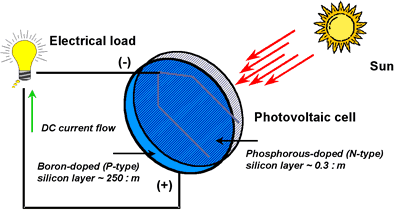
Diagram of Photovoltaic Cell
"A typical silicon PV cell is composed of a thin wafer consisting of an ultra-thin layer of phosphorus-doped (N-type) silicon on top of a thicker layer of boron-doped (P-type) silicon. An electrical field is created near the top surface of the cell where these two materials are in contact, called the P-N junction. When sunlight strikes the surface of a PV cell, this electrical field provides momentum and direction to light-stimulated electrons, resulting in a flow of current when the solar cell is connected to an electrical load. Regardless of size, a typical silicon PV cell produces about 0.5 – 0.6 volt DC under open-circuit, no-load conditions. The current (and power) output of a PV cell depends on its efficiency and size (surface area), and is proportional to the intensity of sunlight striking the surface of the cell. For example, under peak sunlight conditions a typical commercial PV cell with a surface area of 160 cm2 (~25 in2) will produce about 2 watts peak power. If the sunlight intensity were 40 percent of peak, this cell would produce about 0.8 watts." [ from Photovoltaic Fundamentals ]
Recently there have been promising developments in this area. See, for example, Squeezing More Juice out of Solar Panels:"University of California scientists working at Los Alamos National Laboratory have experimentally demonstrated a phenomenon in which semiconductor nanocrystals respond to photons by producing multiple electrons. The innovation has potential applications in a new generation of solar cells that would produce as much as 35 percent more electrical output than current solar cells."
Solar energy, however, can also be harnessed in more modest, low-end, but perhaps even more important ways. For example, the Solar Oven Development and Testing Project at the above-mentioned Florida Solar Energy Center, aims at developing "low-cost panel type solar ovens [ … ] to improve the performance, reliability and cost-effectiveness of low-cost solar cookers for use in developing nations." Such a project is not as trivial as it may sound. In order to develop a practical system, it is necessary to provide a low-tech way of keeping the reflectors in their optimal orientation relative to the sun. High-tech variations on this them are represented by the so-called "solar furnaces." See, for example, High-Flux Solar Furnace:"The 10-kilowatt solar furnace has three principal components: a heliostat, a primary concentrator and a refractive secondary concentrator. The heliostat is a large (32 square meters) flat mirror that tracks the sun as it moves from east to west and reflects the sunlight onto the primary concentrator. The primary concentrator is made up of 25 curved mirror facets, each measuring roughly 0.5 square meters, that reflect the sunlight a second time and focus it at a target area inside the test building. The primary concentrator reduces the beam of sunlight to a 10-centimeter diameter and concentrates it to approximately 2,500 suns at the focal point. Special optical devices can be placed at the focus to significantly increase the concentration. Reflective secondary concentrators can deliver 20,000 suns; refractive secondary concentrators can achieve 50,000 suns. A solar furnace enables the user to very rapidly heat the surface of a sample. In some cases, the temperature rise exceeds thousands of degrees Celsius per second. For high-temperature coatings on metals and ceramics—where it is advantageous to heat only the surface of the material without affecting the base material—a solar furnace can be ideal."
-
A good introduction to tidal energy can be found at the Atlas Project,
"a major initiative aimed at establishing an information base to support the energy Research and Technological
Development strategy undertaken by the European Network of Energy Agencies."
"Tidal energy exploits the natural rise and fall of coastal tidal waters caused principally by the interaction of the gravitational fields of the Sun and the Moon. Some coastlines, particularly estuaries accentuate this effect creating tidal ranges of up to 11 m. Tide mills were in use on the coasts of Spain, France and the UK before 1100 AD and in tidal estuaries (e.g. the Schelde river in Belgium) around 1800 AD. They remained in common use for many centuries, but were gradually replaced by cheaper and more convenient methods of power generation. A tide mill consisted of a pond filled through a sluice during the flood tide and emptied on the ebb tide via an undershot waterwheel. The modern version of a tide mill is a semi-permeable barrage built across an estuary, allowing flood waters to fill an impounded basin via a series of sluices. At high water the sluice gates are closed, creating a head of water on the ebb tide. Electricity is generated by releasing the water through a series of conventional bulb turbines. In future schemes the energy yield would be enhanced by pumping water into the estuary on the flood tide ('flood pumping'), thereby increasing the volume of water released through the turbines on the ebb tide. A variant is tidal stream (or marine current) technology, which aims to exploit the strong tidal currents which are found in shallow seas, particularly where natural constrictions exist, such as around headlands or between islands. Tidal stream technology is in its infancy. Devices similar to submerged wind turbines would be used to exploit the kinetic energy in tidal currents."
-
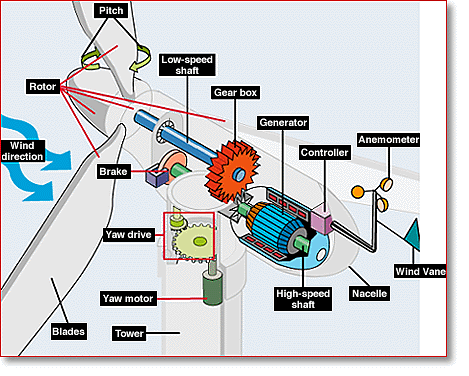
Schematic Diagram of a Wind Turbine
"Simply stated, a wind turbine works the opposite of a fan. Instead of using electricity to make wind, like a fan, wind turbines use wind to make electricity. The wind turns the blades, which spin a shaft, which connects to a generator and makes electricity. Utility-scale turbines range in size from 50 to 750 kilowatts. Single small turbines, below 50 kilowatts, are used for homes, telecommunications dishes, or water pumping." [ from Find Out About How the Turbine Works at the The Wind Energy Program of the US Department of Energy ]
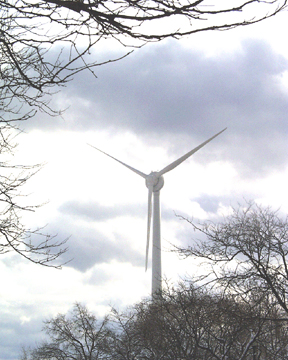
Canada's First Urban Wind Turbine in Toronto
Readings, Resources and Questions
-
A few resources on sustainability and energy efficiency:
UC Berkeley: Center for Information Technology Research in the Interest of Society (CITRIS)
Center for Renewable Energy and Sustainable Technology
Lawrence Berkeley National Laboratory: Energy Crossroads -
Here are a few extra resources on energy alternatives:
Alternative Energy
Alternative Energy
Alternative Energy Sources Could Support Life on Europa
The Bioenergy Cycle: A Vision of the Future
Climate Change
Fuel Cell Today
National Renewable Energy Laboratory
Office of Energy Efficiency Canada
Sustainable Development Directory
US Energy Information Administration - Visit the Geobacter Project at the University of Massachusetts (Amherst). "Geobacter species are of interest because of their novel electron transfer capabilities, impact on the natural environment and their application to the bioremediation of contaminated environments and harvesting electricity from waste organic matter …"
- Read the concise but informative History of Solar Energy at the California Solar Center.
-
Here are a few of the major enviromental protection agencies:
Canadian Environmental Assessment Agency
Environmental Impact Assessment Centre
European Environment Agency
US Environmental Protection Agency - Identify and discuss some of the hidden costs of the technologies discussed above.
© Copyright Luigi M Bianchi 2003-2005
Picture Credits: Miami University · Sweet Briar College
University of Central Florida · EERE · Toronto Hydro
Last Modification Date: 29 October 2005
Picture Credits: Miami University · Sweet Briar College
University of Central Florida · EERE · Toronto Hydro
Last Modification Date: 29 October 2005